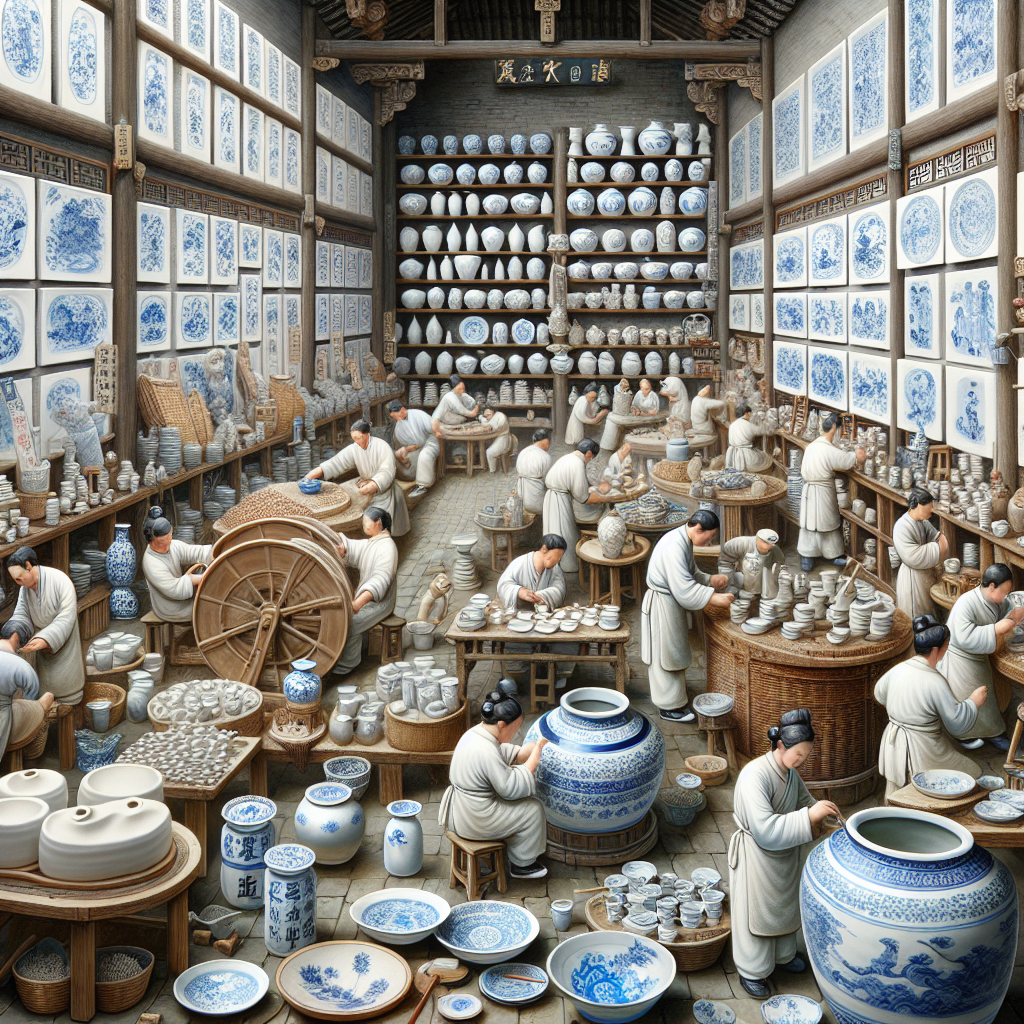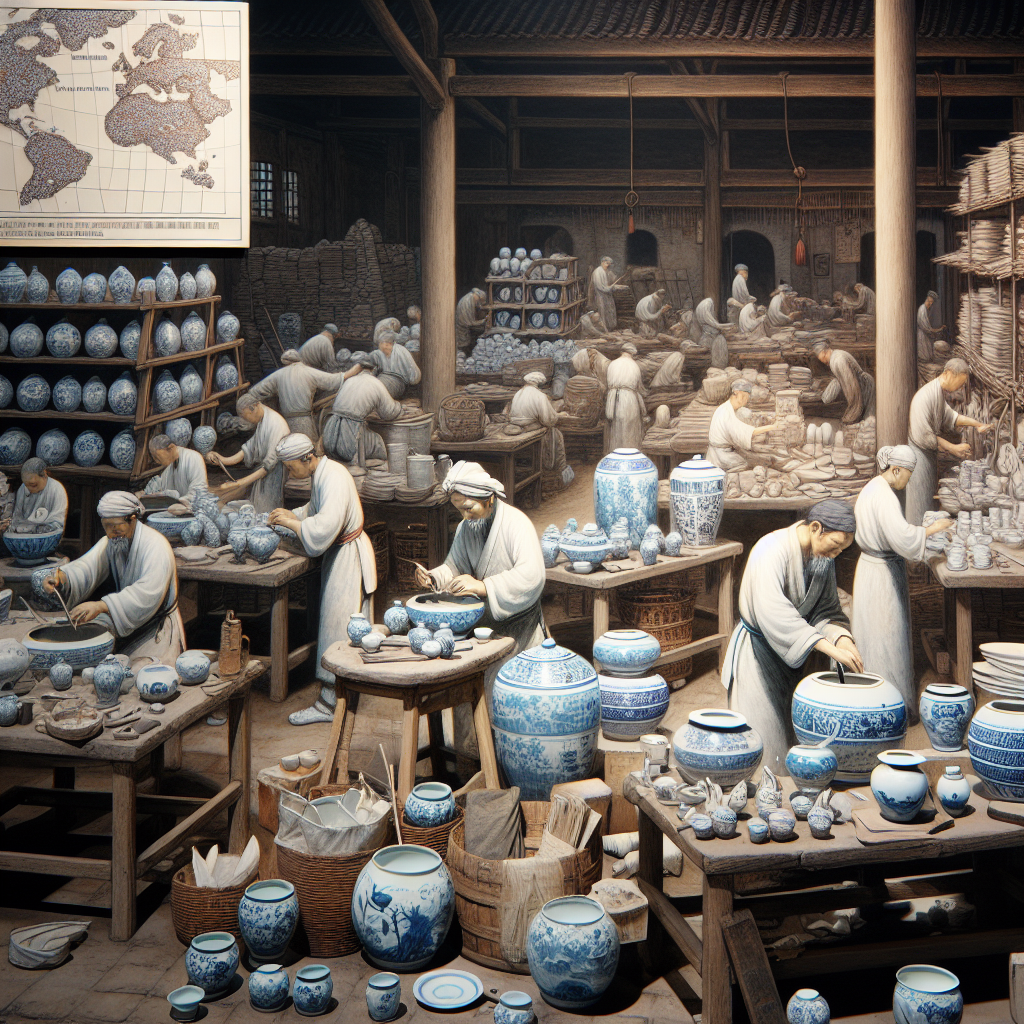Chinese porcelain production and trade has captivated the imagination of art collectors, historians, and enthusiasts for centuries. Renowned for its intricate designs, vibrant colors, and delicate craftsmanship, Chinese porcelain holds a special place in the world of fine art and luxury goods. From the ancient kilns of Jingdezhen to the bustling markets of the Silk Road, the history of Chinese porcelain production and trade is a fascinating tale of innovation, creativity, and cultural exchange. Join us as we embark on a journey to unravel the mysteries of this cherished art form, exploring the techniques, trade routes, and cultural significance of Chinese porcelain throughout history.
The Origins of Chinese Porcelain

Ancient Chinese Ceramics
Chinese ceramics have a rich history dating back to ancient times, with evidence of pottery production found as far back as the Neolithic period. The mastery of pottery techniques laid the foundation for the development of more refined ceramic art forms, including porcelain.
Development of Porcelain in China
The development of porcelain in China is a complex and intricate process that spans centuries. Known for its delicate beauty and durability, porcelain is highly valued in Chinese culture. The production of porcelain involves the careful selection of high-quality clay, meticulous shaping and firing processes, and the application of intricate decorative techniques such as underglaze painting and glazing.
Through the centuries, Chinese artisans perfected the art of porcelain production, creating exquisite pieces that were highly sought after both domestically and internationally. The trade of Chinese porcelain along the ancient Silk Road and maritime routes played a crucial role in spreading Chinese ceramic artistry to distant lands, influencing the development of ceramics in various cultures around the world.

Techniques and Processes in Chinese Porcelain Production
Chinese porcelain production has long been revered for its intricate techniques and meticulous processes. The creation of these exquisite pieces involves a combination of skill, tradition, and innovation.
- Materials Used
Chinese porcelain is crafted using a specific blend of materials that contribute to its unique qualities. The primary components include kaolin, a pure white clay known for its plasticity, and a variety of other minerals such as quartz and feldspar. These materials are carefully selected and combined to form a clay body that is both durable and aesthetically pleasing.
- Firing Techniques
One of the crucial steps in Chinese porcelain production is the firing process, which requires precision and expertise. Kilns are used to subject the porcelain to high temperatures, typically ranging from 1,200 to 1,400 degrees Celsius. The firing process not only hardens the clay body but also allows the glazes to melt and form a smooth, glass-like surface.
- Glazing Methods
Glazing plays a vital role in enhancing the beauty and functionality of Chinese porcelain. Various glazing techniques are employed, including dipping, pouring, and brushing. Glazes are composed of different minerals and oxides that produce a range of colors and finishes. The application of glaze requires a steady hand and an understanding of how different glazes interact with the clay body during firing.
The intricate interplay of materials, firing techniques, and glazing methods in Chinese porcelain production showcases the mastery and artistry of the craftsmen who have upheld this tradition for centuries.
Historical Significance of Chinese Porcelain Trade
- Ancient Trade Routes
Chinese porcelain trade dates back to ancient times, with the Silk Road playing a crucial role in facilitating the exchange of goods between China and the West. The intricate network of trade routes allowed Chinese porcelain to reach distant lands, showcasing the advanced craftsmanship and artistic prowess of Chinese artisans. This trade not only brought economic prosperity to China but also fostered cultural exchange and mutual understanding between civilizations.
- Influence on Global Trade
The demand for Chinese porcelain had a profound impact on global trade dynamics, shaping the patterns of commerce and diplomatic relations. European powers eagerly sought to establish direct trade links with China to satisfy the growing appetite for these exquisite ceramics. The allure of Chinese porcelain also fueled exploration and colonization efforts, as nations vied for control of lucrative trade routes and sought to emulate the craftsmanship of Chinese artisans. The widespread popularity of Chinese porcelain served as a catalyst for the development of global trade networks and laid the foundation for the interconnected world we see today.
Impact of Chinese Porcelain on Art and Culture
Chinese porcelain has had a profound impact on art and culture, shaping aesthetic tastes and social hierarchies in significant ways. This exquisite form of ceramics has influenced various aspects of artistic expression and societal structures throughout history.
-
Aesthetic Designs
Chinese porcelain is renowned for its intricate and diverse aesthetic designs, ranging from delicate blue and white motifs to elaborate colorful patterns. These artistic creations reflect not only the technical skill of the craftsmen but also the cultural influences and historical narratives embedded in each piece. The detailed craftsmanship and artistic ingenuity showcased in Chinese porcelain have inspired artists and designers worldwide, influencing the development of decorative arts and ceramic traditions in different cultures.
-
Ceramics as Status Symbols
In Chinese society, porcelain has long served as a symbol of wealth, power, and social status. The production of exquisite porcelain was often commissioned by the imperial court and nobility, showcasing the opulence and prestige of the ruling elite. Owning fine porcelain pieces became a status symbol among the elite classes, with intricately designed ceramics displayed in palaces, temples, and elite households to demonstrate the owner’s refined taste and social standing. The significance of Chinese porcelain as a status symbol extended beyond China, as these luxurious items were highly sought after in international trade and diplomatic exchanges, further solidifying their cultural and economic value.
Challenges and Competition in Chinese Porcelain Industry
In the realm of Chinese porcelain production and trade, challenges and competition play a significant role in shaping the industry landscape. Understanding the dynamics of these factors is crucial for unraveling the mysteries surrounding this ancient craft.
- Competition from Other Countries
The Chinese porcelain industry faces fierce competition from other porcelain-producing countries such as Japan, Korea, and European nations. These competitors have developed their own unique styles and techniques, challenging the traditional dominance of Chinese porcelain in the global market. The emergence of new players in the industry has led to heightened competition for market share and consumer attention, pushing Chinese porcelain producers to innovate and differentiate their products to stay competitive.
- Technological Advancements

Technological advancements present both opportunities and challenges for the Chinese porcelain industry. While innovations in production techniques and machinery have the potential to enhance efficiency and quality, they also pose a threat to traditional craftsmanship and artisanal skills. As the industry adopts modern technologies to streamline production processes, there is a risk of losing the intricate artistry and cultural heritage that define Chinese porcelain. Balancing tradition with innovation is a critical challenge for Chinese porcelain producers as they navigate a rapidly evolving global market.
Preservation and Conservation of Chinese Porcelain
- Challenges in Preservation
- Chinese porcelain, known for its delicate nature and intricate designs, poses unique challenges in preservation due to its fragility and susceptibility to damage over time.
- The primary concern lies in preventing physical damage such as cracks, chips, and breakage, which can occur during handling, transportation, or improper storage.
-
Environmental factors such as fluctuations in temperature, humidity levels, and exposure to light can also contribute to the deterioration of Chinese porcelain artifacts.
-
Conservation Efforts and Techniques
- Conservation efforts for Chinese porcelain involve a combination of preventive measures and restoration techniques to ensure the longevity and integrity of these historical treasures.
- Preventive measures include proper handling procedures, climate-controlled storage facilities, and the use of specialized display cases to protect porcelain from external elements.
- Restoration techniques often involve the meticulous repair of damaged pieces using reversible adhesives and materials that are compatible with the original composition of the porcelain.
- Conservationists may also employ advanced imaging technologies such as X-rays and CT scans to assess the condition of porcelain objects and inform conservation decisions.
FAQs: Unraveling the Mysteries of Chinese Porcelain Production and Trade
What makes Chinese porcelain so unique?
Chinese porcelain is known for its fine craftsmanship, exquisite designs, and translucent appearance. One of the key factors that make Chinese porcelain unique is the use of high-quality kaolin clay, which gives the porcelain its distinctive white color and strength. The firing techniques perfected by Chinese artisans over centuries also contribute to the durability and beauty of Chinese porcelain.
How did the production of Chinese porcelain evolve over time?
Chinese porcelain production has a long and rich history, dating back to the Eastern Han Dynasty (25-220 AD). Over time, Chinese artisans developed new techniques such as underglaze painting, overglaze enameling, and the use of cobalt blue and copper red glazes. These innovations helped Chinese porcelain become highly sought after throughout the world and fueled a thriving trade industry.
What role did trade play in the spread of Chinese porcelain?
Trade played a crucial role in the spread of Chinese porcelain to other parts of the world. During the Song Dynasty (960-1279 AD), China established the Maritime Silk Road, allowing Chinese porcelain to be exported to countries in Southeast Asia, the Middle East, and Europe. Chinese porcelain became a valuable commodity in international trade and influenced the development of ceramic production in other countries.
How did Chinese porcelain influence other cultures?
Chinese porcelain had a profound influence on the ceramic traditions of other cultures. For example, Islamic potters in the Middle East were inspired by Chinese porcelain techniques and designs, leading to the development of intricate pottery known as “Iznik ware.” In Europe, Chinese porcelain was highly coveted and imitated, leading to the establishment of porcelain factories in countries such as Germany and England.
What are some famous Chinese porcelain styles and regions?
Some of the most famous Chinese porcelain styles include blue and white porcelain from the Ming Dynasty (1368-1644), famille rose porcelain from the Qing Dynasty (1644-1912), and celadon porcelain from the Song Dynasty. Different regions in China were known for their unique porcelain production, such as Jingdezhen in Jiangxi province, which has been a center of porcelain production for over a thousand years.
0 Comments